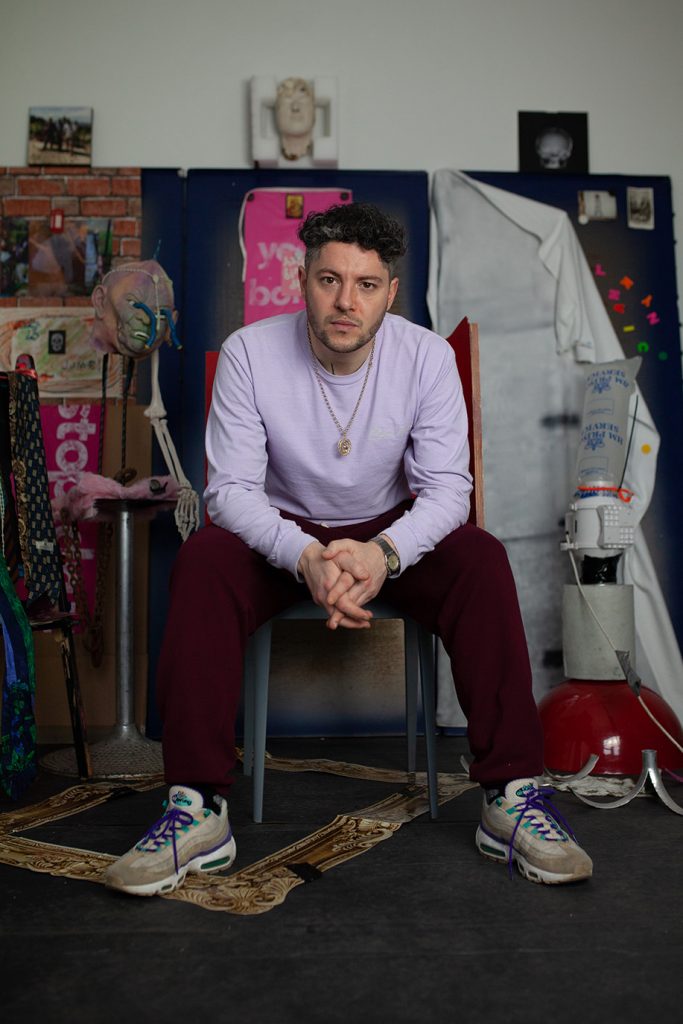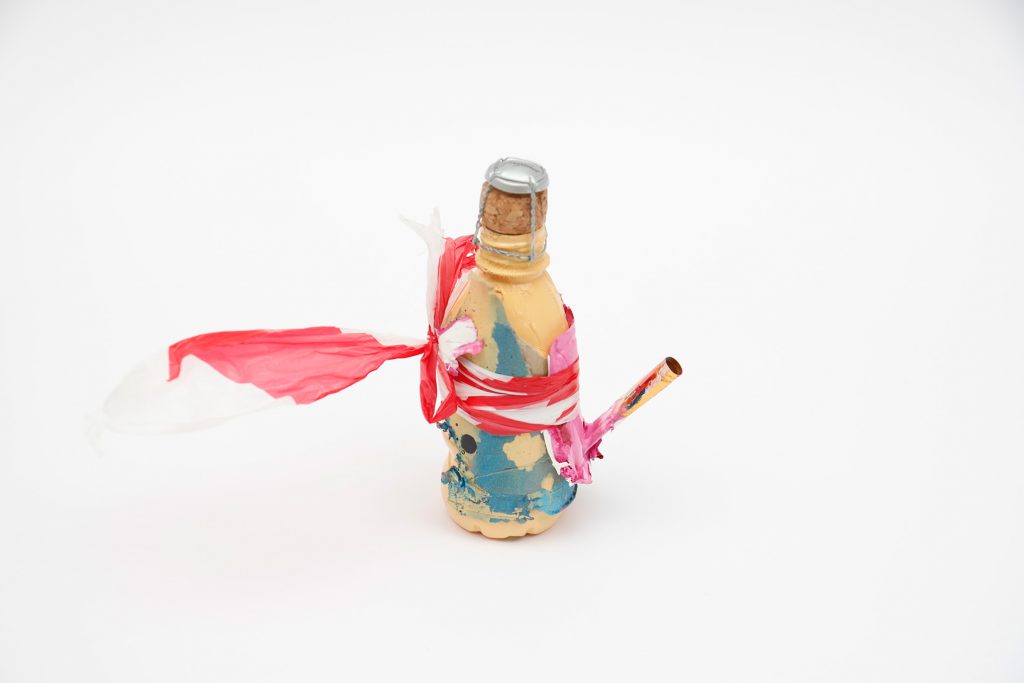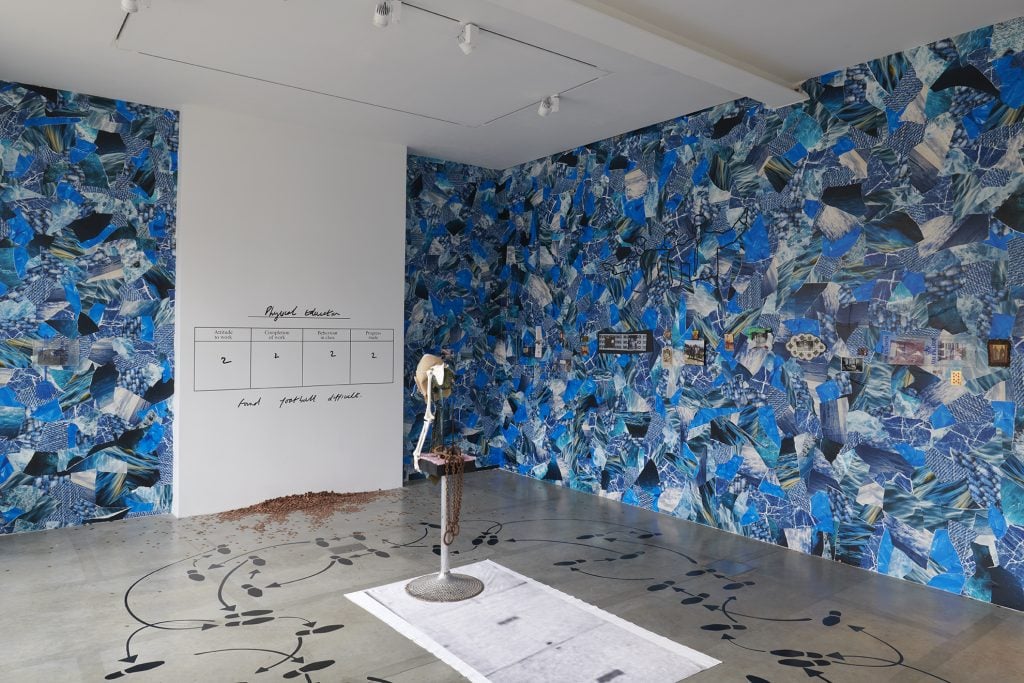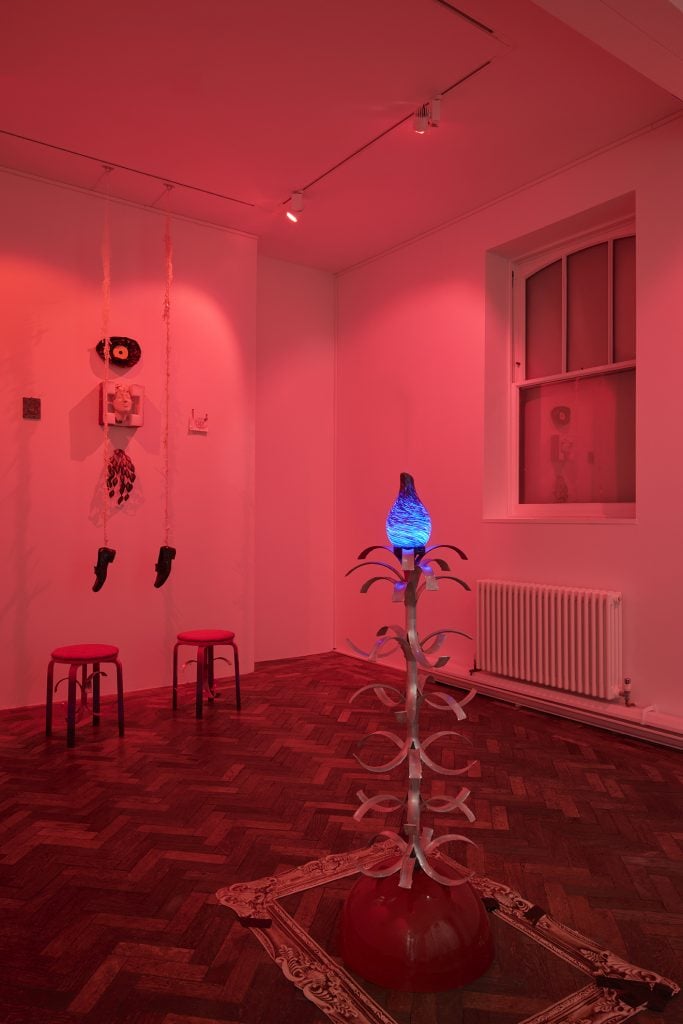Art & Exhibitions
An Ex-Inmate’s Art Confronts Male Fragility With Raw Emotion (and a Pair of Singing Gucci Loafers)
John Costi’s exhibition at South London Gallery is an assault on the senses.

John Costi’s exhibition at South London Gallery is an assault on the senses.

Emily Steer

When I visited John Costi near the end of his six-month residency at South London Gallery’s Fire Station, he plugged a pair of Gucci loafers into his computer.
Both shoes are dipped in thick shiny black paint and wired up with speakers which play sound from the heel. One of them plays a rap that Costi wrote as a teenager, while the other spouts a poem written by the artist as an adult, considering his time spent incarcerated for armed robbery.
“You have to laugh, don’t you?” he smiled while the shoes played his teenage rap. He refers to Gucci loafers as aspirational for young London gang members.

John Costi, ART CRACK PIPE (2020). Courtesy of the artist. Photo by John Costi.
The work is on view in “Found Football Difficult” (through June 18), the conclusive exhibition of his residency. “There are a lot of personal sound pieces in the show that are quite dark, but still a bit of tongue-in-cheek humor there,” he later told Artnet News.
The multi-disciplinary artist’s distinctive work is formed from deeply personal subject matter, woven through with musings on masculinity, family and the U.K. prison system. The show takes its title from feedback Costi received in a childhood report card: In lieu of football, he had to find other ways of forging his own definition of masculinity.
The aural overload of two shoes delivering different recordings at the same time is characteristic of Costi’s work, which grabs visitors’ attention from all angles. There is a lot going on in the exhibition, which awakens multiple senses through scent, sound, a cacophony of visual stimuli, and the invitation to take part in his installation by dancing or flicking pennies at the wall. “There are gaps that are left for people to figure out things for themselves,” he said. “But if you don’t notice the references then maybe they aren’t for you.”

“John Costi: Found Football Difficult,” South London Gallery, March 2023. Installation View. Photo: Jo Underhill.
The exhibition covers two rooms, representing day and night; rebirth and death. The rebirth room draws on different elements of Costi’s family life. A collaged blue denim wall pays homage to the goddess Aphrodite and the artist’s Cypriot heritage; Versace’s Blue Denim perfume can be smelled; archive family photos of previous generations are enlarged on the walls; a totemic installation in the center of the room represents an IPP prisoner (Imprisonment for Public Protection sentences were imposed from 2005 to 2012 with indeterminate timeframes; nearly 3,000 imprisoned under the controversial sentence are still stuck in the prison system long after its dismantling). Visitors are invited to dance around it, with foot marks laid out on the floor.
The death room pumps smoke from multiple points in a long gutter along one side wall; a huge photo of his brother as a child wearing a t-shirt emblazoned with Harry Enfield’s famous catchphrase “Loadsamoney” sits on another wall; a diffuser fills the room with the scent of Joop! for Men; along the back wall, a human form made of the Gucci loafers, a sculptural model of a head framed with rough wood and nails and other found objects, is pinned crucifix-like. The figure represents the artist, or at least a past version of himself, who he is trying to outrun.

“John Costi: Found Football Difficult,” South London Gallery, March 2023. Installation View. Photo: Jo Underhill.
“Suicide is quite a big theme in the second room,” he said. “Dangling loafers is quite a potent image to me. The more that I go into my thirties the more I worry about finding dangling loafers: my uncle killed himself and then two friends have hung themselves. Suicide is the only thing I know that’s killing men. That and excess.”
This autobiographical exhibition draws on Costi’s lived experience; growing up in North London; aspiring to fit an ideal; his time spent in prison for armed robbery; discovering a new side of himself through making art; finding his own version of masculinity. The narrative could be framed as a redemption arc with a happy ending: “reformed convict finds joy through art.” But Costi’s work doesn’t tie everything up neatly: there is warmth and love to be found in references to his past, and a suspicion of the present, particularly the art world and its acceptance of working-class culture only when contained within the neat borders of the art itself.
“It’s easy to patronize and talk about how charming working-class sensibility is,” he said. “It’s the same as any kind of activism being commodified or hijacked. Pain or joy. Art is not real and this whole thing is luxury. My parents didn’t have time to make art because they were too busy working. It might have taken me going to prison to make art. I think you have to be really careful with any kind of marginalized person. Their stories are always going to be fascinating to people who don’t have to go through shit.”
The idea of what it means to be a man is pervasive in Costi’s work. “I think in my life I have been lucky to have very strong women around,” he said. “Some gender lines have been blurred in terms of what strength and weakness is. Some of the things I associated with masculinity are kind of weak. The only emotion men are allowed to show is anger. Reactionary sort of behaviour. We can see masculinity as something silly and heteronormative like being able to change a tire in a car, or we could allow people to make artwork about their friends killing themselves.”

“John Costi: Found Football Difficult,” South London Gallery, March 2023. Installation View. Photo: Jo Underhill.
While a lot of the work reflects thoughtfully on his time spent in prison, there are irreverent moments too: three large blue metal panels in his studio that bear family photographs are in fact marketing boards from the North London bookie he went to prison for robbing. There are also highly sensitive elements to the show, including recorded readings of letters written by his mum and incarcerated friends at the time of his imprisonment.
Costi sees his art practice as one of the key things that changed his life. While institutionalized he took part in an art therapy programme as part of the healthcare wing’s refurbishment. Then in the last six months of his sentence he was granted day release to take part in a fine art course at Kensington and Chelsea College. This was followed by training at Central Saint Martins. But the route for those incarcerated to explore their creativity is still hugely limited. He notes that his experience of prison was very much one of punishment rather than attempted rehabilitation.
“This is something I’m not very hopeful about,” he said. “In prison you don’t really see rehabilitation or any kind of healing. You see segregation and punishment. The things I have seen help people, or at least give people the hope of being able to change, are things like the King’s Fund, or writing a song, or reading a poem. That’s where one can heal, but the system isn’t going to do that for you.”
“John Costi: Found Football Difficult” is on view through June 18 at South London Gallery.